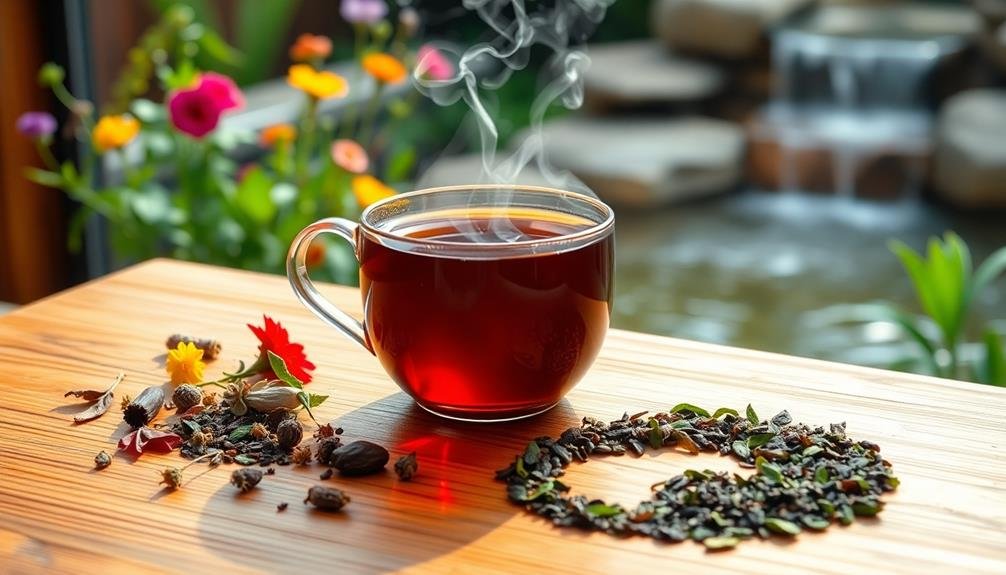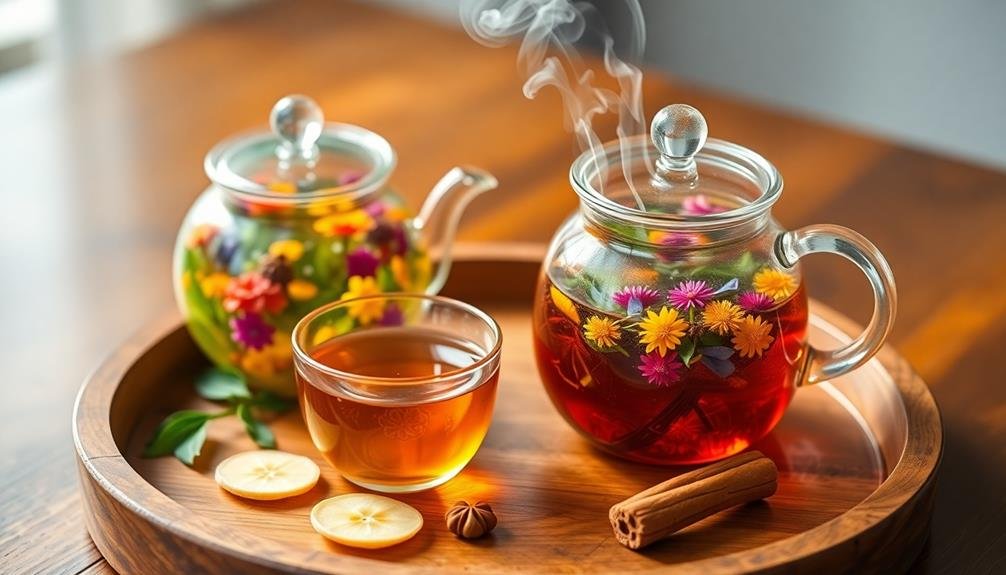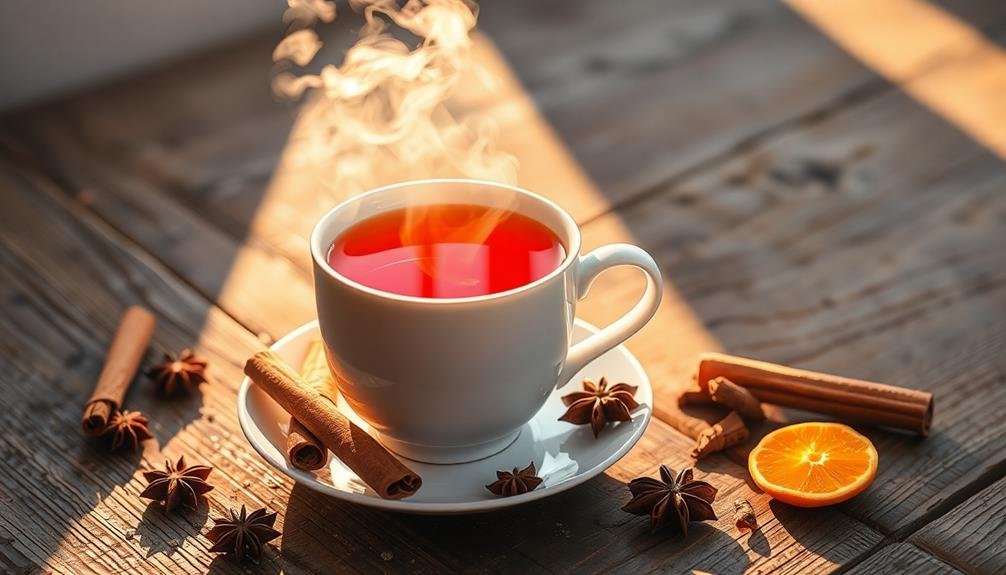Feng Shui-inspired tea blends offer a unique approach to creating harmonious infusions. You'll balance the five elements—Wood, Fire, Earth, Metal, and Water—through carefully selected herbs and botanicals. Start with a high-quality base tea, then add flavor enhancers and visual elements that complement each other. Consider the yin and yang of flavors, as well as the energetic properties of ingredients. Aim for a balance of the five basic tastes: sweet, sour, bitter, salty, and umami. By applying these principles, you'll craft teas that not only taste delightful but also promote overall well-being. Discover how each element can transform your tea experience.
Understanding Feng Shui Tea Principles

How can ancient Chinese wisdom enhance your tea experience? By applying Feng Shui principles to your tea blending, you'll create harmonious infusions that balance the five elements: Wood, Fire, Earth, Metal, and Water.
Each element corresponds to specific flavors, herbs, and energies.
Wood represents growth and energy, associated with sour tastes and herbs like lemongrass or mint. Fire embodies passion and transformation, linked to bitter flavors and stimulating ingredients such as ginger or cinnamon. Earth symbolizes nourishment and stability, connected to sweet tastes and grounding herbs like licorice root or chamomile.
Metal signifies clarity and structure, related to pungent flavors and aromatic herbs like lavender or rosemary. Water embodies flow and intuition, tied to salty tastes and cooling herbs such as seaweed or cucumber.
To create a balanced blend, combine herbs from different elemental categories. Consider your intention for the tea – whether it's to energize, calm, or focus – and select herbs accordingly.
Pay attention to the color, aroma, and taste of your blend, ensuring a harmonious balance that pleases your senses and aligns with your desired outcome.
Essential Elements in Tea Blending
Building on the Feng Shui principles of tea blending, let's explore the key components that make up a well-crafted tea blend. When you're creating a harmonious tea mixture, you'll need to take into account the base, the flavor enhancers, and the visual elements.
Your base tea sets the foundation and can be black, green, white, or oolong. It's essential to choose a high-quality base that complements the other ingredients.
Flavor enhancers add depth and complexity to your blend. These can include herbs, spices, fruits, or flowers. You'll want to balance these elements carefully, ensuring they don't overpower the base tea.
Reflect on the following when selecting flavor enhancers:
- Aroma: Choose ingredients that create an inviting scent
- Taste: Aim for a balanced flavor profile that isn't too bitter or sweet
- Health benefits: Include ingredients known for their medicinal properties
Visual elements are the final touch to your blend. They can include colorful flower petals, citrus peels, or whole spices.
These not only enhance the appearance but can also contribute to the overall flavor and aroma. Remember, a visually appealing blend can greatly enhance the tea-drinking experience.
Balancing Flavors and Energies

Achieving the perfect balance of flavors and energies is essential when crafting a harmonious tea blend. You'll need to take into account the five basic tastes: sweet, sour, bitter, salty, and umami. Each ingredient contributes its unique flavor profile, and your goal is to create a blend where no single taste overpowers the others.
Start by selecting a base tea, such as green, black, or oolong. Then, add complementary herbs and botanicals to enhance the flavor and bring balance. For example, pair astringent herbs with sweet ones to create a well-rounded taste.
Reflect on the yin and yang of flavors: cooling mint can balance warming ginger, while earthy rooibos complements bright citrus notes.
Don't forget about the energetic properties of your ingredients. In feng shui, each element (wood, fire, earth, metal, water) has specific characteristics. Incorporate herbs that represent different elements to create a balanced energy in your blend.
For instance, combine woody rosemary (wood element) with spicy cinnamon (fire element) and grounding chamomile (earth element). By thoughtfully balancing flavors and energies, you'll create a truly harmonious tea blend.
Creating Wood Element Infusions
You'll find creating wood element infusions to be an invigorating practice in tea blending.
Start by exploring herbs that promote growth and liveliness, such as nettle or dandelion, to create energizing green tea blends.
Experiment with floral and citrus combinations like jasmine or lemongrass to add depth and brightness to your wood element teas.
Balancing Herbs for Growth
Growth embodies the essence of the Wood element in Traditional Chinese Medicine. When crafting your Wood element tea blend, focus on herbs that promote energy, flexibility, and new beginnings. These herbs often have a slightly sweet or pungent flavor profile and can support liver function, which is closely associated with the Wood element.
To create a balanced Wood element infusion, consider incorporating these key herbs:
- Peppermint: Known for its cooling and invigorating properties, peppermint supports liver function and aids digestion.
- Dandelion root: This bitter herb helps cleanse the liver and promotes overall detoxification.
- Nettle leaf: Rich in nutrients, nettle supports growth and renewal while offering anti-inflammatory benefits.
As you blend these herbs, aim for a harmonious combination that reflects the Wood element's qualities. You might add a touch of sweetness with licorice root or balance the blend with a small amount of lemon balm for its calming effects.
Energizing Green Tea Blends
With the Wood element as your guide, creating invigorating green tea blends can elevate your tea-drinking experience to new heights. Green tea's natural energy aligns perfectly with Wood's dynamic essence, making it an ideal base for stimulating infusions.
To craft a truly invigorating blend, combine high-quality green tea with herbs and botanicals that complement its uplifting properties. Consider adding peppermint or spearmint for a revitalizing boost, or ginger for its warming and stimulating effects. Lemongrass can introduce a bright, citrusy note that enhances mental clarity. For an extra punch of antioxidants, incorporate goji berries or dried pomegranate seeds. These additions not only amplify the tea's invigorating qualities but also create a complex flavor profile.
When blending, aim for balance. Start with a ratio of 2 parts green tea to 1 part additional ingredients, adjusting to suit your taste. Experiment with different combinations to find your perfect invigorating blend.
Floral and Citrus Combinations
Bursting with vibrant flavors, floral and citrus combinations epitomize the Wood element's essence in tea blending. These invigorating infusions capture the energy of growth, renewal, and liveliness associated with spring.
You'll find that pairing delicate floral notes with zesty citrus creates a harmonious balance, awakening your senses and energizing your spirit.
To craft your own Wood element tea blend, consider these classic floral and citrus pairings:
- Jasmine and lemon: A fragrant green tea base with jasmine petals and lemon zest
- Lavender and orange: Calming lavender buds combined with tangy orange peel
- Rose and grapefruit: Romantic rose petals balanced by tart grapefruit segments
When brewing these blends, use water just below boiling to preserve the delicate floral aromas. Steep for 3-5 minutes, allowing the citrus oils to infuse fully.
You'll notice how the floral notes provide a gentle backdrop while the citrus adds a bright, uplifting quality. Sip these Wood element teas to boost creativity, support decision-making, and embrace new beginnings in your life.
Fire and Earth-Inspired Blends

Two elemental forces come together in fire and earth-inspired tea blends, creating robust and grounding flavors.
You'll find these teas offer a perfect balance of warmth and stability, ideal for centering yourself or boosting your energy.
Fire-inspired ingredients like cinnamon, ginger, and red peppercorn bring heat and stimulation to your cup. They're known to increase circulation and metabolism, giving you a natural lift.
Earth elements, such as roasted dandelion root, burdock, and chicory, provide a deep, rich base that grounds the blend and supports digestion.
Try combining smoky lapsang souchong with earthy pu-erh for a bold, complex brew. Add a pinch of cayenne for an extra fiery kick.
For a milder option, mix rooibos with cacao nibs and a touch of chili. This blend offers a chocolatey warmth with a gentle spice undertone.
Don't forget about yerba mate, a naturally caffeinated herb that embodies both fire and earth qualities.
Blend it with roasted barley and a dash of turmeric for a uniquely invigorating and grounding experience.
These fire and earth-inspired blends will help you feel both energized and centered throughout your day.
Metal and Water Tea Combinations
Balancing the cool, crisp elements of metal with the flowing, adaptable nature of water creates tea blends that refresh and cleanse.
You'll find these combinations particularly soothing and purifying, perfect for clearing your mind and restoring balance.
When crafting metal and water-inspired blends, consider incorporating herbs and ingredients that embody these elements' qualities. For metal, look to astringent and mineral-rich plants like white tea, chrysanthemum, or peppermint.
Water-aligned ingredients include those with a fluid, adaptable nature, such as marshmallow root, licorice, or seaweed.
To create your own metal and water tea blend, try this simple formula:
- Choose a base tea (white or green tea work well)
- Add 1-2 metal-aligned herbs (e.g., peppermint, lemon balm)
- Incorporate 1-2 water-aligned herbs (e.g., marshmallow root, hibiscus)
Experiment with ratios to find your perfect balance.
You'll notice these blends often have a clean, crisp taste with a smooth, hydrating finish.
They're excellent for promoting mental clarity, supporting healthy digestion, and encouraging a sense of calm and adaptability in your daily life.
Frequently Asked Questions
Can Feng Shui Tea Blends Improve My Home's Energy?
You can't directly improve your home's energy with Feng Shui tea blends. However, drinking calming teas can enhance your mood and mindset, indirectly affecting your perception of your home's atmosphere. Focus on traditional Feng Shui practices for better results.
Are There Specific Brewing Methods for Feng Shui-Inspired Teas?
You'll find no specific brewing methods for feng shui-inspired teas. Instead, focus on mindful preparation. Use clean water, steep carefully, and serve in a peaceful setting. This approach aligns with feng shui principles of balance and harmony.
How Long Do the Effects of Feng Shui Teas Last?
You'll find the effects of feng shui teas vary. They typically last 1-3 hours, but it's not an exact science. Your mindset, the tea's quality, and your body's response all play a role in how long you'll feel the benefits.
Can I Mix Feng Shui Teas With Coffee or Other Beverages?
You can mix Feng Shui teas with other beverages, but it's not recommended. It's best to enjoy them on their own to fully experience their unique flavors and benefits. If you're craving variety, try different Feng Shui tea blends instead.
Are There Any Potential Side Effects of Drinking Feng Shui Tea Blends?
You should be aware of potential side effects when drinking feng shui tea blends. While generally safe, some herbs may cause allergic reactions or interact with medications. It's best to consult your doctor before trying new herbal teas.
In Summary
You've now explored the art of creating harmonious tea blends inspired by Feng Shui principles. By understanding the elements and their energies, you're able to craft balanced infusions that nourish both body and spirit. Remember, it's not just about taste, but also about achieving harmony in your cup. Experiment with different combinations, trust your intuition, and enjoy the journey of discovering your perfect Feng Shui-inspired tea blend. Keep sipping and stay balanced!





Leave a Reply